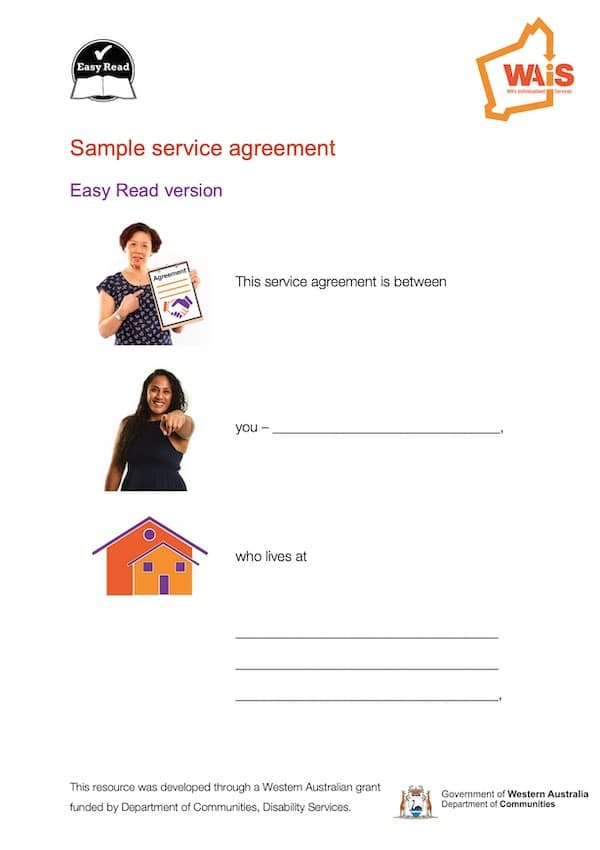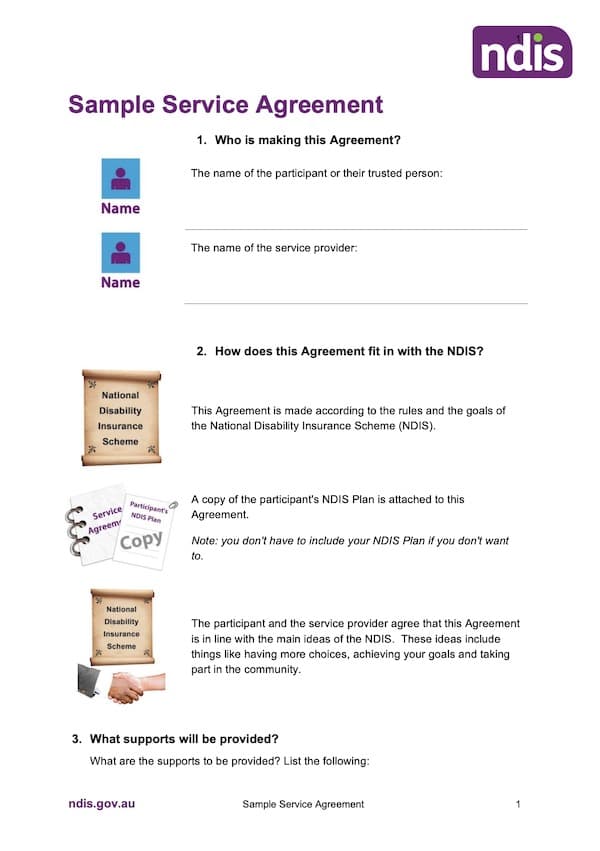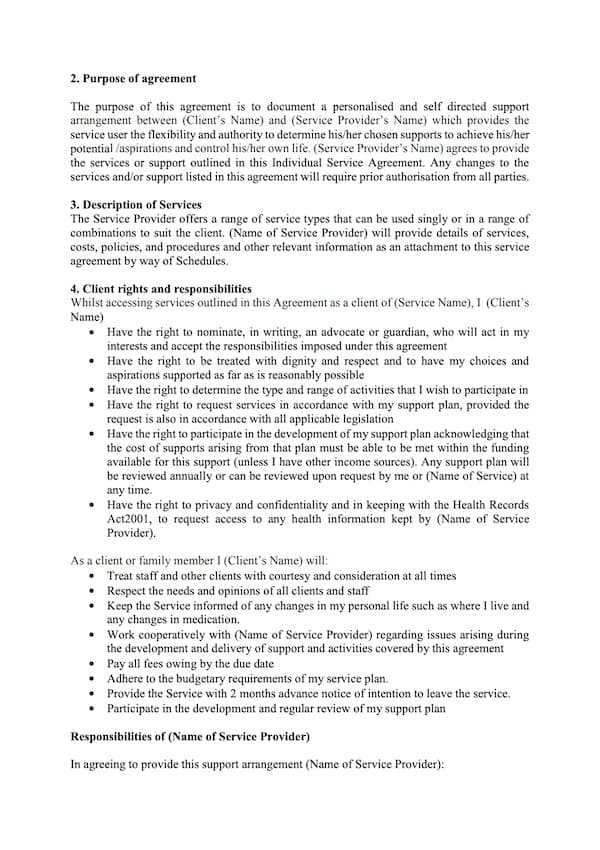
The Complete NDIS Service Agreement Template [Word & PDF]
As an upcoming NDIS provider, working with a premade NDIS Service Agreement Template can be a great way to start off your journey without much trouble.
You probably already thought about creating an agreement from scratch but, as you might have noticed, this is an effort worth a lot of headaches.
So, is there a better way around this?
While service agreements aren’t mandatory, they do provide security for both providers and participants.
Ensuring the required details from the NDIS are included within your service agreement is important, but making a service agreement more complicated than it needs to be undermines the participants’ trust with your services.
You don’t want that to happen.
So we created the perfect NDIS Service Agreement Template for you.
Got it? Great.
Now let’s unpack the document.
How can you write a simple service agreement that’s fair for both parties and doesn’t confuse the participant? What information should you include and why?
Let’s answer these questions.
What An NDIS Service Agreement Looks Like
A service agreement is a legal contract between two parties: the provider and the participant. It is a document highlighting all the different scenarios related to providing the necessary supports based on a participant’s NDIS plan.
Both parties should benefit from this agreement.
It shouldn’t lean too heavily on either side.
Before you get to issuing one of these, it’s best to understand what they’re supposed to do. A great way to do this would be looking at other providers’ service agreements.
1. WA’s Individual Services

This is an “Easy Read” version filled with images that is perfectly suitable as a legal document. Again, agreements needn’t be overly complex to get the job done.
Here’s what this 23-page template includes:
- Provider and participant personal information and contact details as well as contractual terms with start/end dates.
- A brief section explaining how to use the document and a comprehensive table of contents to help participants navigate the information.
- Concise explanations on what the agreement is for, what the responsibilities of each party are, and how payments with the provider work.
- Terms on how to rectify or cancel the agreement in case something goes wrong or a few details need to be added/changed/removed.
- The cancellation policy, information on how to deliver feedback for the services provided, and various signature boxes to close the deal.
This type of delivery is great and it simplifies the process greatly for both providers and participants. Feel free to draw inspiration from WAIS’s document!
2. The Official NDIS Service Agreement Template

A similar approach to our first example is a document delivered by the NDIS as part of the provider toolkit. This is a lean 5-page document that showcases most of the sections highlighted in our first example with a few notable exceptions:
- Once the terms of the agreement are understood, this template provides the participant with a section regarding GST (Goods and Services Tax). Here the participant receives information about how GST works against the NDIS.
- Also, the document refers back to the Guide to Service Agreements to make sure that everything is covered for your specific use case.
Of course, a 5-page document is an oversimplification of the agreement. You should take this document as reference and fill in the information based on participant needs, geographic location, specialization, and everything that’s unique to your business.
3. Carers Australia

Finally, we have Carers Australia’ service agreement template which is a text-heavy, 10-page document with a more formal tone compared to the first two examples. The document is divided into nine sections:
- Section 1 goes through all the terms covered in the document to help the reader better understand the context of formal language.
- Sections 2 to 4 include most of what we’ve already seen in the first two examples: purpose of agreement, description of services, and expectations for what should be delivered and/or received on behalf of both parties.
- Section 5 is a short paragraph highlighting the dispute process in case conflicts arise between the service provider and the participant.
- Sections 6 to 8 cover payment terms as well as service quality assurance from the provider and potential reviews and audits from the government. While formal in language, the sections are short and easy to understand.
- Finally, section 9 has all the signature boxes necessary to close the deal with the participant and move on to delivering the services.
Writing an agreement like this one is not a bad thing as long as the participant is able to understand the language used on their own.
Using simple language is especially important when working with self-managed participants. Plan managers can handle complex agreements better.
Generally speaking, it’s better to start simple and build upon your agreements rather than fill them with unnecessary jargon which confuses the participants.
The first two agreements do a great job of this by adding images to each section while the third one is a bit heavier.
Why Service Agreements Are Important

Whether you’re just starting out or you’ve been in the game for a while, you’ve probably noticed that long-winded agreements are complex to manage.
Yet having an agreement with your participant is a great thing.
When done well, it protects both parties from any liability.
Having a well-structured template for each situation can go a long way in helping you manage your NDIS business without undermining your clients’ trust with your services.
A few reasons why service agreements are important:
- They formalize a relationship with the participant
Yes, service agreements tend to be a formality, but they exist for a good reason. The NDIS is rather strict in the way participants receive their funding, so it’s important for the latter to know that they can trust a service provider in full. The same can be said for participants who should deal with payments promptly upon delivery.
- They protect your income in case conflicts arise
We all try to avoid them, but they can happen. Conflicts are a part of business… Sometimes they arise due to negligence from either party, or sometimes they spark due to small inconsistencies which add up to become major annoyances. Whatever the case, clear terms on how to resolve disputes can save your business many legal headaches.
- They are relevant from a legal standpoint
All terms written in a service agreement are legally binding. This means that all sections are enforceable by law and that both parties are bound to the terms. With a thorough commitment from the provider side and a clear understanding from the participant’s, it’s beneficial to have a contract that protects the parties’ rights each step of the way.
These are just a few of the benefits. If you’re interested to learn more about what a service agreement can do to help your NDIS business thrive, check out the official page and the quality and safeguards commission page.
In the meantime, you can start working with our templates and build a strong, long-term relationship with your newly-found customers!
Delivering Fair Terms For Both Parties

Participants are usually the more vulnerable party in the NDIS equation. Your job as a provider is to help them feel welcome—not scare them away with complex papers.
Formal agreements have their place even in the NDIS world but we recommend sticking to a simpler approach initially and build on top of a solid foundation. With the template provided in this article, you have a solid baseline to start building trust with your clients.
Need Help creating Service Agreements and other aspects of running an NDIS organisation? Let Us Help
NDIS providers are tasked with upholding a great quality of care for their clients. And Brevity Care is there each step of the way. As an NDIS Digital Partner, Brevity Care software was built from the ground up to be an NDIS-specific tool aligned to the NDIS Practice Standards and Operational Guidelines that empowers NDIS providers to streamline their business operations.
Whether you provide direct supports, plan management, support coordination, therapy or SIL, Brevity has you covered. Contact us today to find out how Brevity help grow your organisation.
Originally published May 8, 2020
Frequently Asked Questions
An NDIS service agreement is a contract between a service provider and a participant. This document can be fully customized to the participant’s needs or it can be delivered as a premade template. To write an effective agreement, the most important thing to consider is whether the participant will be able to understand the information and how he can navigate the delivery of service from the provider.
Generally, no. Service agreements are only mandatory in case you offer Specialist Disability Accommodation supports under the NDIS rules. All other services do not require it.
In a service agreement, you should always include: provider and participant contact information, start/end dates, contractual terms, responsibilities on both sides, terms of payment, terms on how to rectify or cancel the agreement, a dispute policy, and a short paragraph on GST before getting to the signature boxes.
Most services offered by NDIS providers are GST free. If this is the case for your practice, then yo do not need to mention GST in your service agreement. Please refer to the price guide for exceptions.



